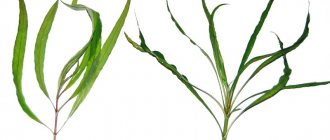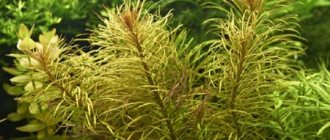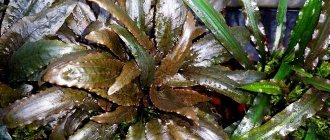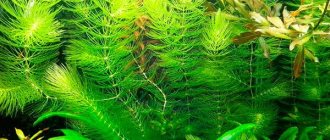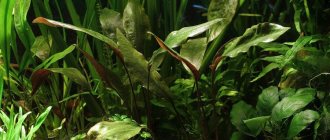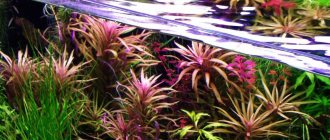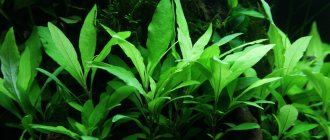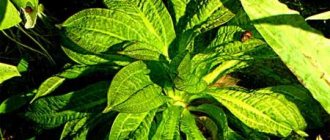This family includes several species of perennial plants in the form of fluffy “Christmas trees” on long thick stems. Absolutely all types of cabomba have excellent decorative properties: after all, their thin leaves resemble pine needles of different colors, ranging from lush green to bright red options. Among other things, this underwater miracle can bloom, becoming even more festive and beautiful.
The plant came from the countries of South America, also Brazil. It grows near shallow rivers and streams, where the current is moderate and weak. Aquarium options are characterized by rapid growth, good adaptation to any conditions, and the ability to saturate water with oxygen. They are good places for fry and other small fish to hide.
Main appearance characteristics
The leaf blade has a rounded outline up to 9 cm, which contains up to 500 small thread-like segments. The slightly branched stem has a round cross-section and usually spreads throughout the aquarium under the weight of its own weight. The leaves are opposite, without stipules, initially pink or crimson, later turning green, collected in whorls of three or four. They have a smooth and shiny surface.
After the shoot reaches the surface of the water, a flower arrow forms on it, blooming with the formation of small white flowers that form on the sepals and grow singly. Flowering usually occurs in early spring.
The plant has a fibrous root system with thin and brittle roots that can spread over considerable distances.
Botanical description and natural habitat
A flowering aquatic plant belonging to the order Pitcher-flowered, family Cabombaceae, naturally found in tropical and subtropical freshwater bodies of North and South America. Prefers shallow rivers and streams with moderate or weak currents. Active growth throughout the year allows the bottom of small reservoirs to be covered almost completely.
The length of the dense, fleshy stem can reach 2 meters in length. There are many branches on it, forming a lush spreading bush. Leaves grow on the branches in large quantities, each on a separate petiole. One leaf includes up to 50 narrowed segments in the shape of a finely dissected fan.
Photo gallery of Kabomba:
Kabomba roots are poorly developed, spread along the surface of the soil, and are easily injured. During flowering periods, small yellow inflorescences appear on high stalks, located in the axils of the leaves. Depending on the variety, the shades of the flower may vary slightly to a darker or lighter side.
Famous varieties of kabomba
Although there are many varieties of this aquarium inhabitant, we can still note the most famous and popular of them. This:
| Kinds | Description | Main content parameters |
| It has a long erect stem, green leaves, up to 5 cm wide. The flowers are yellow. | Daylight hours are at least 8-12 hours, temperature range is 22-27, acidity is neutral or slightly acidic (5.5-6.8), hardness is less than 8. |
| The stems are not too branched, the leaves have a fan-shaped shape, the color of which varies from green to scarlet. | Requires a temperature of at least 24 degrees, hardness within 6. |
| It has ruby red stems, grows up to 40 cm, and is better suited for the background. | Loves lighting in the range of 0.7-1 W/l, temperature from 24 degrees, feeding with microfertilizers. |
| It is distinguished by a silvery tint, the leaves have a dissection, it grows up to 25-30 cm. Thin leaves are twisted in spirals. Differs in slow growth. | It is necessary to provide 12 hours of lighting and heat above 24 degrees, otherwise growth will slow down. Requires slightly acidic, soft water, cannot withstand a hardness of more than 6. Requires very bright light. |
| The stems are highly branched and have a reddish color. | The most demanding, therefore less common. The required temperature is 20-28, only very soft water (no more than 4), neutral or slightly acidic environment is suitable. With high rigidity, the size of the leaves decreases and growth deteriorates. Loves bright lighting. |
Maintenance in an aquarium
Taking into account the individual characteristics of the species considered, experts recommend growing Carolina cabomba, since it is the easiest to care for. Important requirements include the following:
- the presence of bright light (up to 50 Lm/l or more), but direct exposure to the sun’s rays, which are harmful to plants, is undesirable: the aquarium is placed away from the window and supplied with artificial light;
- Sand, well washed, or small pebbles are suitable as soil; loves nutritious soil;
- maintaining normal hydrochemical parameters;
- the frequency of fertilizing depends on the types of cabomba;
- possibility of additional saturation of water with CO2;
- the duration of daylight should be more than 12 hours;
- the bottom litter must have sufficient heaviness and density to quickly settle after cleaning and have minimal turbidity;
- ensuring good filtration, since suspensions on the leaves can lead to the death of the plant;
- mandatory weekly change of 25% of the aquarium water.
All types of cabomba are suitable for starting new aquariums and creating a balance of nitrogen compounds, especially at first.
And when maintained for a long time, it does an excellent job of maintaining biological balance and has a beneficial effect on the inhabitants of the tank.
Planting rules
Decorative algae does not have a very strong and developed root system. Given this feature, it is recommended to plant cabomba in an aquarium in crushed pebbles or sifted sand. It is desirable that there be a thin layer of silt on the surface of the planting soil, enriched with nutritional components. Its total height should not exceed 5−7 cm.
When starting to plant the purchased plant, it is necessary to trim the lower part of the root by a couple of centimeters along with the adjacent leaves. Next, the algae is placed in the prepared substrate and pressed well, but part of the rhizome should remain above the ground. Otherwise, rotting of the root system may occur, resulting in the complete death of the cabomba.
Feeding after algae has settled in the aquarium is recommended , but not mandatory. For this purpose, it is customary to use red clay, formed into small balls. Usually it is laid out in close proximity to the rhizomes. The described grass quickly takes root and begins to stretch its stems upward.
Important! If there is any type of cabomba in the aquarium, you should use copper sulfate and various means for treating fish with caution. They can damage the plant, which will quickly shed its leaves. You should first consult a specialist.
Hybrophyte often dies due to repeated pruning and insufficient carbon dioxide. An original decorative result is achieved when planting kabomba fish in groups in containers.
Reproduction tricks
The main method of propagation for these plants is the vegetative method, using shoots and cuttings. To get a dense bush, it is advisable to pinch off part of the top of the specimen. Divide the shoots themselves into pieces so that each of them has a thin root. When planting a child specimen in the ground, it is advisable to leave a couple of leaves on the surface itself. Cabomba is immediately planted in a permanent habitat, since due to frequent transplants it can get sick.
For propagation, it is better to take the lower part of the stem with roots or apical cuttings, which develop much faster than the intermediate part.
What does Carolina cabomba look like?
This perennial plant is distinguished by the following features:
The stem is long, thin, erect, weakly branched. It begins to spread at the surface of the water.
The leaves on the underwater stem are arranged oppositely or in a whorl of three leaves. They have a palmately dissected leaf plate in the shape of a fan with long thin segments. The upper leaves are floating, whole, arranged alternately. All leaves have petioles.
The roots are thin, fibrous, underdeveloped, and are strengthened in the soil.
The flowers are solitary, located in the axils of floating leaves.
Landing Features
The process is unlikely to cause any difficulties. It is advisable to plant not very deeply, leaving part of the root system on the surface, so as not to cause rotting and further death of the specimen. For these purposes, silted soil is selected or at first fertilizing is done with fertilizers, although this is not necessary. The role of fertilizer can be performed by red clay, which is laid out in the form of balls near the root during planting. Planting stages:
- choosing cuttings or purchasing planting material;
- careful examination for dry, rotten areas with a view to removing them;
- disinfection of purchased cuttings in any disinfecting solutions (potassium permanganate, for example);
- removal of lower leaves that interfere with rooting;
- planting and sprinkling with sand, but not too deep.
If you take the central part of the shoot, it will initially stop developing until a root system is formed.
At first, the shoot can be fixed with a pebble until it takes root. The use of copper sulfate has a negative effect on the entire condition of the plant. The cabomba begins to wither and shed its leaves. Since it is included in many preparations used to treat aquarium fish, it is better to transfer the inhabitants to another container and treat them without harming the cabomba. By the way, these restrictions also apply to the drug Rivanol.
Replanting old plants is often difficult due to the fragility of the creeping roots, so it will be easier to completely remove the old bush by first rooting the top in another place.
If you often have to transfer algae, for example, to a spawning ground, you don’t have to plant them: in a floating state, they develop and grow well, but the roots will remain intact and unharmed.
Why isn't it growing?
Sometimes it happens like this: you seem to be doing everything right, but the result is negative. What could be the reason for poor growth or death of your pet?
| Content factors | Causes and violations |
| Aquarium water parameters | Low or too high temperatures, discrepancy between acidity and hardness parameters |
| Illumination indicators | Violation of the minimum duration of daylight hours, lack of direct sunlight, where necessary, and high-quality artificial lighting. |
| Purity of water composition | It requires the absence of mechanical dirt, regular cleaning and water changes. |
| Errors during landing | Root rotting when planted too deeply. |
| Unwanted plant neighbors | The presence of blue-green algae is considered dangerous for cabomba species. |
| Unwanted Inhabitants | Snails can eat algae, interfering with their development and growth. |
Pests and diseases
If, when planting, you buried the stem of the plant too much, the cabomba may rot. To root, simply press the stem to the bottom with a pebble.
Blue-green algae that grows in hard water is harmful to cabomba. Try to maintain this indicator at a level that is safe for the plant and promptly remove harmful algae from the water.
- Planting crocuses
Among the pests, snails pose a danger to cabomba. Simply remove the shellfish from the aquarium.
The most important condition for the health of cabomba is clean, silted-free water. If you find that the leaves of the plant have changed color and began to wither, break and fall off, immediately clean the aquarium of sediment and silt and change the water.
Do you need fertilizing and fertilizers?
A lack of carbon dioxide dissolved in water can cause leaves to become brittle and fall off. All types of “Christmas trees” do not require a large amount of organic matter, since they receive their main nutrition through their leaves from the environment, and the roots get nutrition from the remains of fish food or other organic waste that have sunk to the bottom of the container.
Any fertilizing will have a positive effect on increasing the speed and development of plants, including increasing color saturation. Root complex tablets (Flora 2), of course, will speed up the survival rate and have a positive effect on their further growth.
Cabomba continues to be almost the most favorite planting and decoration for any aquarium, helping to create wonderful compositions and surprise any contemplator of the aquatic world.

